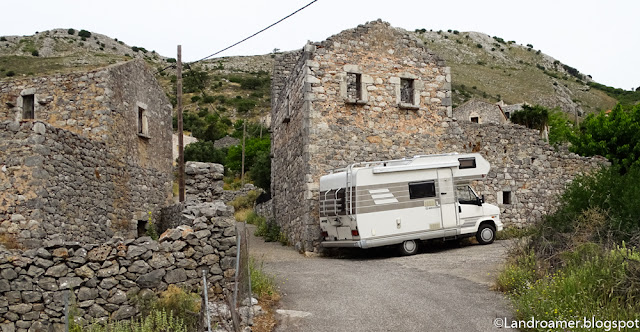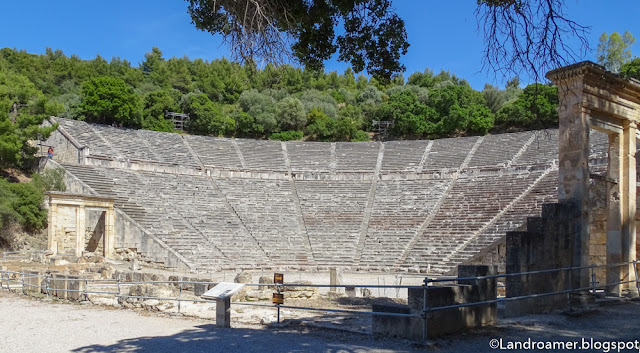This blog relates 3 months of travel
... there are HUNDREDS of pictures,
hence it is divided into subsections
- Peloponnese region => continue to scroll this blog
- Some of the smaller islands of Greece is here
- Santorini : Part of the Cylades group of islands is here
- 1/2 - Crete : Western part of the island is here
- 2/2 - Crete : Heraklion and Eastern part of the island is here
- Islands of the Dodecanese is here
- Central Greece and Corfu island is here
- For lovers of archeological sites... i.e."old stones" is here
- On the road and in town, drink and food, campsites is here
Do NOT try to see all those posts in ONE go!
... Take time to enjoy them in a few sessions.
Because of the Covid lockdown and because my trip
was made during the first part of summer, there were
VERY few other tourists in Greece. In "popular places"
I was able to get pictures with hardly anybody.
During the months of May, June and July, while there were Covid-19 lockdowns in many countries, I "slipped under the radar" to Italy and then Greece, before the restrictions were officially lifted - Because why not? Bye-bye St Cergue - Hello Greece (via San Marino).
St Bernard Pass in the Alps - 2'469 meters
San Marino, officially the Republic of San Marino also known as the Most Serene Republic of San Marino, is a small country (and a European microstate) in Southern Europe enclaved by Italy.
San Marino is a landlocked country but the northeastern end is within 10 kilometres (6.2 mi) of the Italian city of Rimini on the Adriatic Sea. The nearest airport is also in Italy.
Uniquely, San Marino's constitution dictates that its democratically elected legislature, the Grand and General Council, must elect two heads of state every six months. Known as Captains Regent, the two heads of state serve concurrently and hold equal powers until their term expires after six months.
Because of the Covid-19 lockdowns,
hardly any vehicles and passengers on the ferry!
Peloponnese Region - Patras
Olympia and it's games!
Olympia is an ancient town and UNESCO World Heritage Site in Peloponnese, Greece. This was the site of the original Olympic Games from 776 BC. The flame for each modern Olympic Games is still lit in Ancient Olympia, by a reflection of sunlight in a parabolic mirror, and carried by torch to the place where the games are to be held.
On my way to Messene
Most of the area of Ancient Messene contains the ruins of the large classical city-state of Messene refounded by Epaminondas in 369 BC, after the battle of Leuctra and the first Theban invasion of the Peloponnese. Epaminondas invited the return to their native land of all the families that had gone into exile from Messenia during its long struggle with and servitude under the military state of Sparta, now finished as a conquering state.
Currently, the substantial ruins are a major historical attraction. Much of it has been archaeologically excavated and partly restored or preserved for study and public viewing, as well as for various events.
On my way to the Southern tip of Peloponnese
Nafplio is
a an important touristic destination, founded
in antiquity, the city became an important seaport in the Middle Ages, before coming
under the Republic of Venice and, lastly, the Ottoman Empire. The city was the
second capital of the First Hellenic Republic and of the Kingdom of Greece,
from 1827 until 1834.
The ancient theatre of Epidaurus was started in the 4th century BC. The original 34 rows were extended in Roman times by another 21 rows. It seats up to 14,000 people.
The theatre has long had a reputation for its exceptional acoustics, which reportedly allowed almost perfect intelligibility of unamplified spoken words from the proscenium to all 14,000 spectators, regardless of their seating, a tale often recounted by tour guides. In-situ measurements, however, somewhat moderate these claims…
The Corinth Canal connects the Gulf of Corinth in the Ionian Sea with the Saronic Gulf in the Aegean Sea. It cuts through the narrow Isthmus of Corinth and separates the Peloponnese from the Greek mainland, arguably making the peninsula an island. The canal was dug (1881-1893) through the isthmus at sea level and has no locks. It is 6.4 kilometres in length and only 21.4 metres wide at its base, making it impassable for many modern ships. It is currently of little economic importance becoming mainly a tourist attraction.
Athens and Attica
The National Archaeological Museum in Athens houses some of the most important artifacts from a variety of archaeological locations around Greece from prehistory to late antiquity. It is considered one of the greatest museums in the world and contains the richest collection of Greek Antiquity artifacts worldwide. It is situated in the Exarcheia area in central Athens.
The Parthenon is a former temple on the Athenian Acropolis, Greece, dedicated to the goddess Athena, whom the people of Athens considered their patroness. Construction started in 447 BC, it was completed in 438 BC, although decoration of the building continued until 432 BC. It is the most important surviving building of Classical Greece, generally considered the zenith of the Doric order.
Its decorative sculptures are considered some of the high points of Greek art. The Parthenon is regarded as an enduring symbol of Ancient Greece, democracy and Western civilization, and one of the world's greatest cultural monuments.
To the Athenians who built it, the Parthenon, and other Periclean monuments of the Acropolis, were seen fundamentally as a celebration of Hellenic victory over the Persian invaders and as a thanksgiving to the gods for that victory.
For a time, it served as the treasury of the Delian League, which later on became the Athenian Empire. In the final decade of the 6th century AD, the Parthenon was converted into a Christian church dedicated to the Virgin Mary.
After the Ottoman conquest, the Parthenon was turned into a mosque in the early 1460s. On 26 September 1687, an Ottoman ammunition dump inside the building was ignited by Venetian bombardment during a siege of the Acropolis. The resulting explosion severely damaged the Parthenon and its sculptures.
The Temple of Poseidon, in Sounion, was built between 444 and 440 BC, the temple was constructed of marble from the valley of Agrilesa, about four kilometers north of the Sounio Cape. The architect built the 16 columns at the Temple of Poseidon in a way that ensured they would stand the test of time and resist the harshness of the environment, and made the Doric columns more slender at the top so they would look taller. The material and size of these offerings indicate that the Temple of Poseidon was likely frequented by members of the elite and aristocratic class.
To the Greeks, Poseidon was considered to have been the "master of the sea." Given the importance of trade by sea and the significance of their navy in the creation and survival of their nation during the fifth century, Poseidon was of a particular relevance and value to the Athenians.
With boats and ferries, I visited many of
the 166 to 227 inhabited islands of Greece.
=> Welcome onboard to visit :



































































